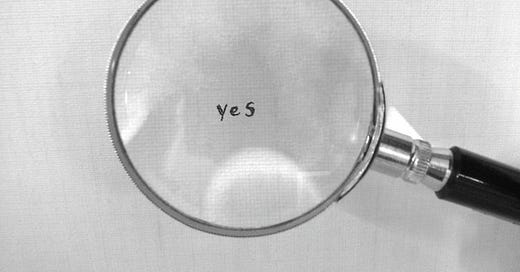The demands of modern living put a large focus on the act of refusal. Saying no is a shield—a means to save time, energy, or the identity one has painstakingly crafted for oneself. No becomes an act of self-preservation, its enclosure keeping one safe. But nothing ever started with a no.
In The Hour of the Star, Clarice Lispector presents yes as the absolute act of creation, the novel itself beginning with the following sentence:
“All the world began with a yes. One molecule said yes to another molecule and life was born.”
In November 1966, the artist Yoko Ono, long before she became known as ‘the woman who broke up The Beatles,’ was about to open her exhibition Unfinished Paintings and Objects at Indica Gallery in London.
John Lennon was invited to visit the gallery by its owner, John Dunbar. He met Ono for the first time while interacting with her art. One piece in particular caught his attention, and perhaps it was the piece that brought them together. It was called Ceiling Piece, and it consisted of a ladder that visitors had to climb in order to reach a magnifying glass attached to the ceiling. Through the magnifying glass, a small word written on the ceiling would become visible. That word was ‘Yes.’
Lennon liked it because he had found most avant-garde art at the time to be anti-something and too negative: “I felt relieved. It’s a great relief when you get up the ladder and you look through the spyglass and it doesn’t say ‘no’ or ‘fuck you’ or something, it said ‘yes.’”
Like climbing a wobbly ladder, it takes some effort and courage to get to the yes. On the way up, one might slip and fall, getting hurt or embarrassing oneself. No is the rational. It comes from a place of control, resistance to change, even fear. As Thomas Merton said, “What you fear is an indication of what you seek.”
Lennon said yes to an invitation. Ono said yes to herself: “I was not happy with my life so I wanted to say ‘yes’ to me. Yes, Yoko, don’t worry. I wasn’t expecting anything. But it worked, didn’t it?!”
As Tina Fey wrote in Bossypants, saying yes is fundamental to improvisation. This is called ‘Yes, and…’ thinking. The idea is to accept what your partner has stated, expand on that line of thought, and follow the path that gets created:
“The first rule of improvisation is AGREE. Always agree and SAY YES. […] Now, obviously in real life you’re not always going to agree with everything everyone says. But the Rule of Agreement reminds you to ‘respect what your partner has created’ and to at least start from an open-minded place. Start with a YES and see where that takes you.”
It is impossible for everything to follow an ideal scenario, or sometimes any scenario. Life itself is an ongoing improvisation. There will be slips and rainy days. What matters is to be able to say yes without expectations—even saying yes to the mistakes—and see where it all leads.
Rain
by Raymond Carver
Woke up this morning with
a terrific urge to lie in bed all day
and read. Fought against it for a minute.
Then looked out the window at the rain.
And gave over. Put myself entirely
in the keep of this rainy morning.
Would I live my life over again?
Make the same unforgiveable mistakes?
Yes, given half a chance. Yes.



